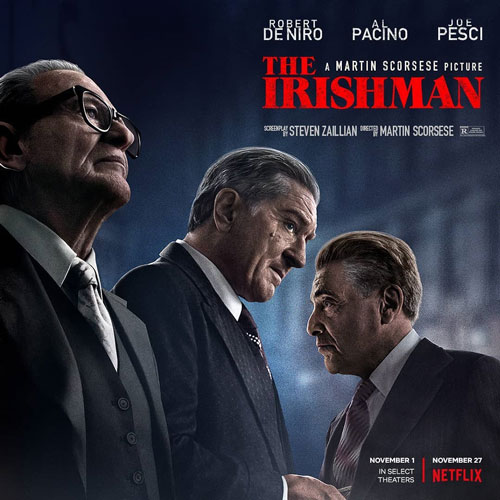
Based off of the true story and novel “I Heard You Paint Houses,” Martin Scorsese’s “The Irishman” is a compelling narrative centered around family, sacrifice, and revenge, as Philly truck driver Frank Sheeran finds his way into organized crime.
Frank Sheeran (Robert De Niro) winds himself into working for Russell Bufalino (Joe Pesci), an elite member of organized crime, completing favors and tasks which range from blowing up taxis to murdering those who stand in the way of Bufalino and his crime family.
Sheeran works his way through the ranks to the right hand of big shot Jimmy Hoffa (Al Pacino) to whom he becomes the personal bodyguard, hitman, and best friend. Hoffa is a powerful union president who has a notable grasp on organized crime, thus Sheeran is constantly pulling favors for both him and Bufalino.
De Niro, Pesci and Pacino perform their roles quite convincingly. Although De Niro’s talents are underutilized, Pesci’s and Pacino’s performances are nothing short of stunning. Supporting actors also perform well, progressing the story and interacting well with others, especially for acting in a time period with which most of them are unfamiliar.
Most of the movie takes place during the ’50s to the ‘70s. The music, fashion, set and props make this obvious and believable, as they should be for a film with an almost $150 million budget.
The music is especially perfect; the soundtrack consists of big band and bebop era jazz, as well as the early rock music one would expect to find in a crime film. Music director Robbie Robertson’s score choices fit every scene perfectly, greatly contributing to the overall tone of the film.
Another aspect of the film which affects the tone is the color grading. Much of the film consists of browns and dull pastel colors, while a few parts feature brighter colors. Whenever the tone is darker, the colors are dark as well, and colors are brighter when the tone is lighter.
Colors are also used to symbolize various things. The wives of Sheeran and Bufalino are seemingly always wearing bright colors that stand out against the dull colors of the rest of the screen. The bright colors seem to symbolize innocence or ignorance, for the wives are never involved with their husbands very closely, but rather just accept them and live their lives almost separately.
One of Sheeran’s daughters, Peggy, tends to wear very flat colors, but is also often seen wearing red lipstick which sticks out on her otherwise tamely colored body. While she doesn’t know exactly what her father does, hence her innocence, she still knows her father does immoral things of which she disapproves, hence the rest of her dull wardrobe.
The red of Peggy’s lipstick and the blood of those who are shot is very prominent atop the flat canvas of the rest of the movie. Other aspects, such as the camera angles and shots of cinematographer Rodrigo Prieto, make moments with blood and death even more significant.
Close ups make the scenes feel personal and even stressful at times; other shots, such as those on dead bodies, linger for an uncomfortable amount of time.
One aspect of the film that some people are conflicted on is its use of computer generated images (CGI). Since the movie takes place over the span of over 50 years, Scorsese utilizes CGI to make De Niro and his co-actors look younger in the earlier parts of the story. Smaller details, such as the color of De Niro’s eyes, also use CGI to maintain factuality.
Anthony Lane of the New Yorker said the film “Could have done without the tinting of [De Niro’s] eyes,” but others felt as though its use was appropriate. “This is an instance of a filmmaker applying CGI as a tool rather than as the focus of the production,” wrote James Berardinelli of Reelviews. While the CGI isn’t atrocious, it sometimes takes away from the movie’s legitimacy in an attempt to appear more real.
However, any legitimacy lost through CGI is regained through the dialogue. Sometimes the dialogue is made up of characters talking at each other meaninglessly, yet it allows viewers to see how characters progress and how mobsters and everyday citizens spoke to one another.
The juxtaposition of the film’s setting and that of today is quite evident as the characters throw around racial and homophobic slurs without weight or backlash. While the film allows society to see how it has progressed in its past 70 years, it still lacks a strong female role. “The film also misses the spiky female presence of a Lorraine Bracco (GoodFellas) or Sharon Stone (Casino),” wrote Ian Freer of Empire in reference to previous Scorsese films.
Despite its handful of errors, “The Irishman” is an excellent story that drops its viewers into history. It makes the viewer emotional when they least expect it, and its means of creating a realistic and powerful experience are on a level where only a handful of other films lie. “The Irishman” will entertain its viewers, as well as remind them what family truly means and the sacrifices one is willing to make for their own.









